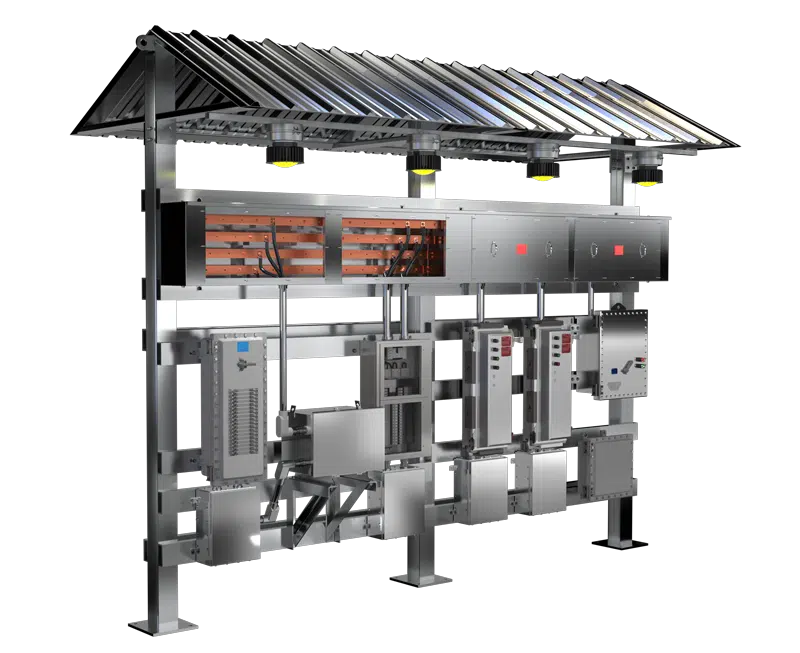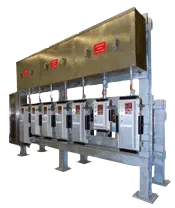
In hazardous location (HazLoc) environments such as refineries, chemical plants, and oil & gas facilities, designing electrical systems demands meticulous attention to safety, reliability, and regulatory compliance. Specifically, engineers tasked with designing switchracks for Class I, Division 1 (Div 1) and Class I, Division 2 (Div 2) areas must thoroughly understand detailed classification guidelines, structural specifications, electrical requirements, and industry best practices. Drawing on insights from IEEE standards and practical expertise demonstrated by Spike Electric Controls, this blog outlines critical considerations every engineer needs to know.
Understanding HazLoc Classifications
Class I areas involve environments where flammable gases or vapors may be present, creating potential explosion risks. The division between Div 1 and Div 2 signifies the frequency and duration of the hazardous atmosphere:
- Class I, Division 1: Hazardous atmosphere present under normal operating conditions.
- Class I, Division 2: Hazardous atmosphere exists only under abnormal conditions, such as leaks or system failures.
Engineers must clearly delineate these classifications during initial project planning, as this directly influences the overall design strategy, equipment selection, and installation practices.
Structural Integrity and Material Selection
Designing compliant switchracks for classified locations begins with robust structural engineering. IEEE guidelines stress the importance of detailed analyses of seismic and wind loads, dictating that switchracks be capable of withstanding severe environmental conditions without compromise.
Spike Electric Controls addresses these stringent requirements by selecting high-strength materials, typically galvanized steel or aluminum, known for corrosion resistance and structural durability. Structural designs feature reinforced vertical supports (I-beams) and horizontal supports (C-channels), ensuring stability and longevity under extreme operational stresses.
Bus Duct and Electrical Distribution Systems
The design of electrical distribution within HazLoc switchracks must ensure reliable and safe operation under fault conditions. According to IEEE, bus duct systems require careful engineering to accommodate short-circuit forces and thermal expansions. Copper bus bars used within these ducts must be robustly braced, insulated, and corrosion-resistant.
Spike Electric employs copper bus bars that meet stringent IEEE and UL specifications, ensuring optimal conductivity and fault protection. Bus ducts are rigorously tested, verified for insulation integrity, continuity, and thermal resistance, guaranteeing operational reliability in hazardous environments.
Conduit Systems and Enclosure Sealing
In Class I locations, properly designed conduit systems and enclosure sealing mechanisms are critical for safety and compliance. Div 1 areas mandate explosion-proof enclosures and seals to prevent internal explosions from igniting external flammable atmospheres. Div 2 areas allow some flexibility, but still require robust sealing and appropriately rated enclosures.
At Spike Electric Controls, each switchrack is designed to precisely match the specified hazardous area classification. Explosion-proof fittings, flame-tight seals, and conduit systems adhere strictly to IEEE, NEC, and UL guidelines, ensuring complete compliance and maximum safety.
Electrical Safety and Protection
Ensuring electrical safety is paramount in HazLoc designs. IEEE standards detail the essential role of protective devices such as circuit breakers, overload relays, and proper grounding methods. Fault conditions in hazardous environments present significant safety hazards, making properly engineered protective measures indispensable.
Spike Electric rigorously applies these safety guidelines, integrating robust circuit protection, precise grounding systems, and advanced arc-flash mitigation techniques. Each protective device is carefully coordinated and tested in factory acceptance tests, ensuring switchracks provide the highest levels of operational safety and protection.
Maintenance and Inspection Accessibility
Designing for maintainability is crucial, especially in hazardous locations. IEEE emphasizes that compliant switchracks must facilitate regular maintenance inspections, corrosion assessments, and electrical integrity tests without compromising safety or requiring shutdowns.
Spike Electric integrates these considerations into every switchrack design, featuring open and accessible layouts, corrosion-resistant components, and clear maintenance procedures. This approach enhances ease of inspection, extends operational life, and significantly reduces downtime associated with routine maintenance.
Practical Advantages of Compliant Design
Designing HazLoc switchracks according to IEEE and UL standards delivers tangible operational and economic benefits. Facilities realize reduced installation times, streamlined commissioning, and enhanced reliability compared to conventional substations or modular installations.
Spike Electric Controls exemplifies these advantages through its turnkey solutions. Switchracks arrive fully assembled, pre-tested, and ready for immediate installation, significantly accelerating project timelines and minimizing costly field labor. The long-term operational benefits, including minimized downtime, reduced maintenance costs, and increased reliability, provide substantial return on investment.
Spike Electric’s Commitment to Engineering Excellence
With years of experience delivering compliant HazLoc switchrack solutions, Spike Electric Controls embodies the best practices outlined by IEEE. Their expert engineering teams precisely interpret client specifications, ensuring every project aligns with the highest safety and operational standards. From meticulous structural design to detailed electrical integration and rigorous safety testing, Spike Electric delivers switchracks that exceed regulatory requirements and client expectations.
Conclusion: Essential Guidelines for Every Engineer
Designing switchracks for Class I, Div 1 & Div 2 environments requires comprehensive understanding and adherence to IEEE standards, combined with practical insights from experienced industry leaders like Spike Electric Controls. By focusing on structural integrity, detailed electrical engineering, rigorous safety measures, and maintainability, engineers can ensure their designs provide exceptional reliability, safety, and economic efficiency.
For engineers working within hazardous locations, adopting these principles isn’t merely advisable—it’s essential. With a clear understanding of classification requirements, structural needs, and electrical compliance, engineers can confidently deliver solutions that not only meet regulatory expectations but also protect lives, investments, and operational continuity.


